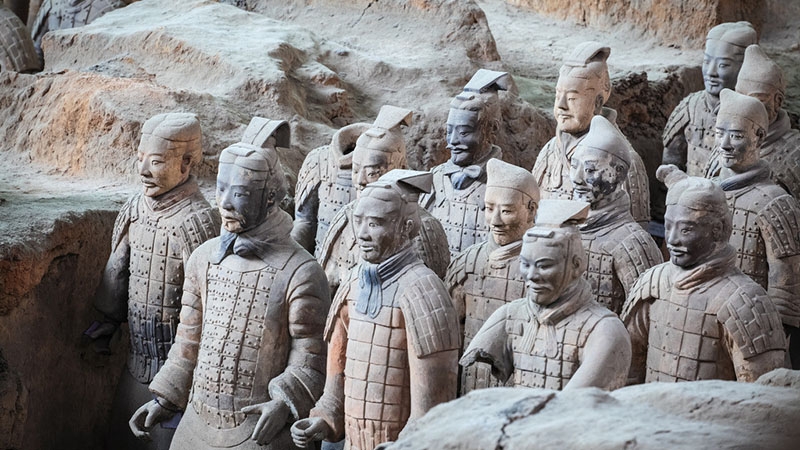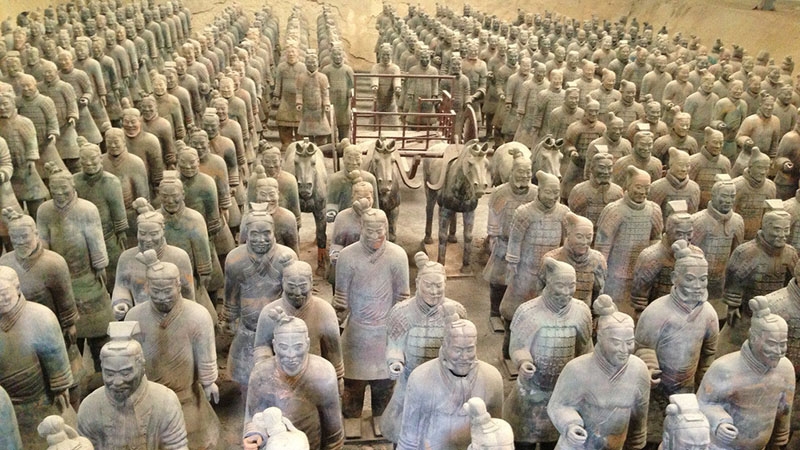008613762194311 | 008613762194311 tour-zhangjiajie@outlook.com
008613762194311 | 008613762194311 tour-zhangjiajie@outlook.com
【Location】Lintong District, Xi'an City
【Type】 World Cultural Heritage Site, Museum
【Rank】 ★★★★★
【Discovery Time】 in 1974
【Recommended Time to stay】 3 hours
【Opening Hours】9:00--17:00
In 221BC, for the first time in its history, China was united one emperor, Qinshihuang of the Qin dynasty.The Qin emperor's influence far out lived his short dynasty. His most important achievement was unifying the various warring kingdoms and integrating writing, money, weights and measures into one centralized and standardized bureaucracy. Like many autocrats, Qin Shihuang had an early start on his own mausoleum; construction began when he was only 14 and continued for 36 years.
 To visit Army of Terracotta Warriors is the main reason why you are here in Xian. The original site was found by a local farmer digging a well in 1974. Now it has turned into the most important attraction in Xian - Terracotta Warriors and Horse Museum. It is located about 50km east of the Xian City. The museum includes Pit 1, Pit 2 and Pit 3 as well the exhibition hall of the chariots and horses. The Pit 1 is the largest of the three. To get there you may take a public bus from Xian Train Station Bus Terminal, or take a taxi or rent a car from a local tour company.
To visit Army of Terracotta Warriors is the main reason why you are here in Xian. The original site was found by a local farmer digging a well in 1974. Now it has turned into the most important attraction in Xian - Terracotta Warriors and Horse Museum. It is located about 50km east of the Xian City. The museum includes Pit 1, Pit 2 and Pit 3 as well the exhibition hall of the chariots and horses. The Pit 1 is the largest of the three. To get there you may take a public bus from Xian Train Station Bus Terminal, or take a taxi or rent a car from a local tour company.
Three pits containing warriors are open, a nearby fourth pit was found empty. The pits are still being excavated and in many; warriors lay toppled as if they fell in combat. Shattered and headless status give the eerie sense of viewing the carnage of an ancient battlefield. Though a daunting task, archeologists continue to piece together the broken remains of those warriors who lost their battle against time.
★Main Scenic Spots
Pit No. 1 is in an oblong shape of tunnel. It is 230 metres long from east to west and 62 metres wide from north to south. It is 5 metres deep. It occupies an area of 14,260 square metres. Inside the tunnel, there are ten earth-rammed partition walls. The floors are bricks-paved. The terra-cotta warriors and horses in Pit No. 1 are lined in a real battle formation. To the east end of the pit stand facing east three rows of terra-cotta warriors in battle tunics and puttees, 70 in each row with total number of 210 put altogether. Armed with bows and arrows, they form the vanguard. The ten rammed partition walls cut Pit No. 1 into eleven latitudinal passage ways. There are 38 columns of warriors in the east with horse-drawn chariots in the centre. The armour-clad warriors carrying long-shaft weapons are probably the main body of the formation and show the main force.
Pit No. 2 is situated 20 metres to the north of Pit No. 1. The Pit is L--shaped and composed of four different mixed military forces in four rows. It is recorded that there were more than 1, 000 pieces of pottery figures, 500 horse-driven chariots and saddled horses. The pit is about 6,000 square metres. While the first pit contains mostly foot soldiers, the second pit is the mobile arm of the army with chariots, cavalry and archers. A tall status, thought to be a general, was also found in this pit.
Pit No. 3 is situated 25 metres to the north of Pit No. 1 and to the west of Pit No. 2. Tthe pit is in the concave shape with 520 square metres. From the pit were discovered one chariot, four terra-cotta horses and 68 clay armoured warriors. In Pit No. 3 were only unearthed one kind of weapon called "shu", which had no blades and are siad to be used by the guards of honour. Discovered also in this pit were a re- maining deer-horn and animal bones. This is maybe the site where sacrificial offerings and war prayers were practiced.
 There is a display hall with two bronze chariots unearthed near the base of the emperor's tomb. These elaborate half-sized chariots are intricately detailed with drivers and horses that have decorated plumes and gold and silver inlaid harnesses. These richly decorated chariots feature working parts such as windows that open and close and turning handles. There are also exhibitions featuring artifacts from the pits, allowing a closer look at the intricate workmanship.
There is a display hall with two bronze chariots unearthed near the base of the emperor's tomb. These elaborate half-sized chariots are intricately detailed with drivers and horses that have decorated plumes and gold and silver inlaid harnesses. These richly decorated chariots feature working parts such as windows that open and close and turning handles. There are also exhibitions featuring artifacts from the pits, allowing a closer look at the intricate workmanship.
Outside the gates of the Terracotta Warriors, present day market warriors will give a shrill battle cry as you approach. They are earned with different wares, from ubiquitous replica terracotta warriors to postcards--the best defense is a good offense and that means bargaining.
★When to visit it
Xi'an is famed for its annual festivals; one of the livelier ones is the Silk Road International Tourism Festival. Every September people gather in down town Xi'an for this even. Fireworks, folk music and dance performances, talent shows, cultural exhibitions are all part of the itinerary.
Previous Page:The last one!
Next Page:The Big Goose Pagoda